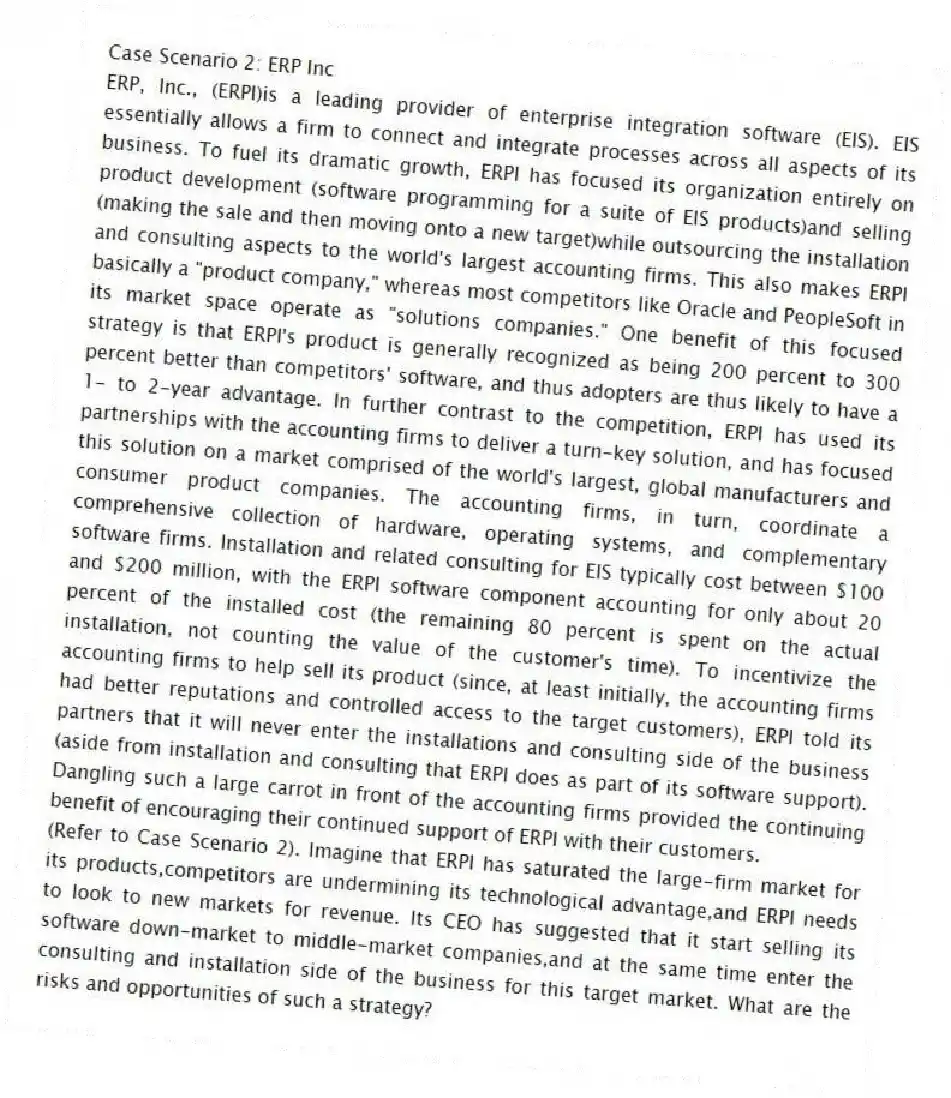
Case Scenario 2: ERP Inc
ERP, Inc., (ERPI)is a leading provider of enterprise integration software (EIS). EIS essentially allows a firm to connect and integrate processes across all aspects of its business. To fuel its dramatic growth, ERPI has focused its organization entirely on product development (software programming for a suite of EIS products)and selling (making the sale and then moving onto a new target)while outsourcing the installation and consulting aspects to the world's largest accounting firms. This also makes ERPI basically a "product company," whereas most competitors like Oracle and PeopleSoft in its market space operate as "solutions companies." One benefit of this focused strategy is that ERPI's product is generally recognized as being 200 percent to 300 percent better than competitors' software, and thus adopters are thus likely to have a 1- to 2-year advantage. In further contrast to the competition, ERPI has used its partnerships with the accounting firms to deliver a turn-key solution, and has focused this solution on a market comprised of the world's largest, global manufacturers and consumer product companies. The accounting firms, in turn, coordinate a comprehensive collection of hardware, operating systems, and complementary software firms. Installation and related consulting for EIS typically cost between $100 and $200 million, with the ERPI software component accounting for only about 20 percent of the installed cost (the remaining 80 percent is spent on the actual installation, not counting the value of the customer's time). To incentivize the accounting firms to help sell its product (since, at least initially, the accounting firms had better reputations and controlled access to the target customers), ERPI told its partners that it will never enter the installations and consulting side of the business (aside from installation and consulting that ERPI does as part of its software support). Dangling such a large carrot in front of the accounting firms provided the continuing benefit of encouraging their continued support of ERPI with their customers.
-(Refer to Case Scenario 2). Imagine that ERPI has saturated the large-firm market for its products,competitors are undermining its technological advantage,and ERPI needs to look to new markets for revenue. Its CEO has suggested that it start selling its software down-market to middle-market companies,and at the same time enter the consulting and installation side of the business for this target market. What are the risks and opportunities of such a strategy?
Correct Answer:
Verified
View Answer
Unlock this answer now
Get Access to more Verified Answers free of charge
Q102: The opportunity maximization approach is more difficult
Q105: Explain the rationales for a cooperative strategy
Q110: Identify the competitive risks associated with cooperative
Q114: Why are cooperative strategies often used when
Q121: Describe the two strategic management approaches to
Q123: Identify and define the two different types
Q130: In managing cooperative strategies,research indicates that
Can be
Q135: Case Scenario 1: Norning International
Norning International (NI)states
Q136: Case Scenario 2: ERP Inc
ERP, Inc., (ERPI)is
Q138: Case Scenario 1: Norning International
Norning International (NI)states
Unlock this Answer For Free Now!
View this answer and more for free by performing one of the following actions

Scan the QR code to install the App and get 2 free unlocks

Unlock quizzes for free by uploading documents